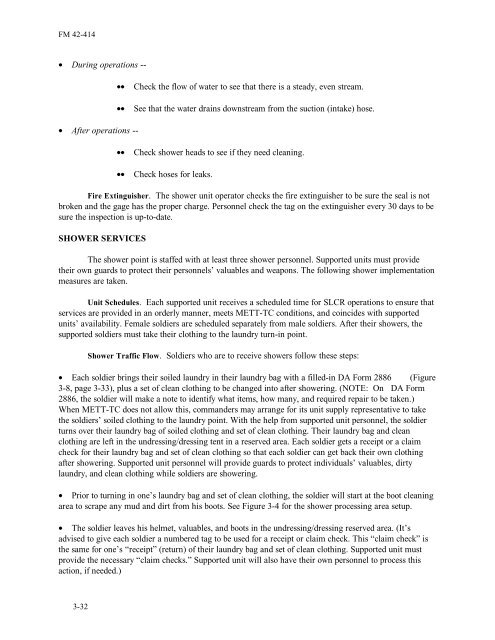Tactics, techniques, and procedures for - Army Electronic ...
Tactics, techniques, and procedures for - Army Electronic ...
Tactics, techniques, and procedures for - Army Electronic ...
Create successful ePaper yourself
Turn your PDF publications into a flip-book with our unique Google optimized e-Paper software.
FM 42-414<br />
• During operations --<br />
• After operations --<br />
3-32<br />
•• Check the flow of water to see that there is a steady, even stream.<br />
•• See that the water drains downstream from the suction (intake) hose.<br />
•• Check shower heads to see if they need cleaning.<br />
•• Check hoses <strong>for</strong> leaks.<br />
Fire Extinguisher. The shower unit operator checks the fire extinguisher to be sure the seal is not<br />
broken <strong>and</strong> the gage has the proper charge. Personnel check the tag on the extinguisher every 30 days to be<br />
sure the inspection is up-to-date.<br />
SHOWER SERVICES<br />
The shower point is staffed with at least three shower personnel. Supported units must provide<br />
their own guards to protect their personnels’ valuables <strong>and</strong> weapons. The following shower implementation<br />
measures are taken.<br />
Unit Schedules. Each supported unit receives a scheduled time <strong>for</strong> SLCR operations to ensure that<br />
services are provided in an orderly manner, meets METT-TC conditions, <strong>and</strong> coincides with supported<br />
units’ availability. Female soldiers are scheduled separately from male soldiers. After their showers, the<br />
supported soldiers must take their clothing to the laundry turn-in point.<br />
Shower Traffic Flow. Soldiers who are to receive showers follow these steps:<br />
• Each soldier brings their soiled laundry in their laundry bag with a filled-in DA Form 2886 (Figure<br />
3-8, page 3-33), plus a set of clean clothing to be changed into after showering. (NOTE: On DA Form<br />
2886, the soldier will make a note to identify what items, how many, <strong>and</strong> required repair to be taken.)<br />
When METT-TC does not allow this, comm<strong>and</strong>ers may arrange <strong>for</strong> its unit supply representative to take<br />
the soldiers’ soiled clothing to the laundry point. With the help from supported unit personnel, the soldier<br />
turns over their laundry bag of soiled clothing <strong>and</strong> set of clean clothing. Their laundry bag <strong>and</strong> clean<br />
clothing are left in the undressing/dressing tent in a reserved area. Each soldier gets a receipt or a claim<br />
check <strong>for</strong> their laundry bag <strong>and</strong> set of clean clothing so that each soldier can get back their own clothing<br />
after showering. Supported unit personnel will provide guards to protect individuals’ valuables, dirty<br />
laundry, <strong>and</strong> clean clothing while soldiers are showering.<br />
• Prior to turning in one’s laundry bag <strong>and</strong> set of clean clothing, the soldier will start at the boot cleaning<br />
area to scrape any mud <strong>and</strong> dirt from his boots. See Figure 3-4 <strong>for</strong> the shower processing area setup.<br />
• The soldier leaves his helmet, valuables, <strong>and</strong> boots in the undressing/dressing reserved area. (It’s<br />
advised to give each soldier a numbered tag to be used <strong>for</strong> a receipt or claim check. This “claim check” is<br />
the same <strong>for</strong> one’s “receipt” (return) of their laundry bag <strong>and</strong> set of clean clothing. Supported unit must<br />
provide the necessary “claim checks.” Supported unit will also have their own personnel to process this<br />
action, if needed.)

















